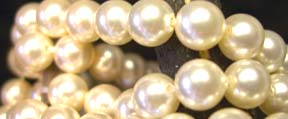Articles by EJA Members
Pearls
by AncaNY
Some jewelers use alexandrite for June and some use pearl. Alexandrite is too expensive, so nowadays, pearls are used more and more.

Pearls: History and Myth
Of the Gods: Considered by Native Americans to be deities tears and by Greek mythology as joyful tears she d by Aphrodite. Ancient Egyptians associated pearls with Isis, goddess of healing and life.
Heavenly Creations: Arab legend tells of moonlight-filled dewdrops falling to the ocean and swallowed by oysters. The ancient Chinese believed them conceived in the brains of dragons. In Hindu culture they were symbols of love and purity, associated with the moon.
The First Pearl: Hindu texts claim Krishna discovered it, presenting it to his daughter on her wedding day.
Ancient Documentation: Chinese historical texts, dating back 4000 years, make the first reference to pearls, actually freshwater pearls. Hieroglyphs record the use of pearls in Egyptian jewelry as far back as 2200 b.c. The oldest pearl necklace in existence may be from ancient Persia, found in the 2400-year old tomb of a princess.
Soldiers of Fortune: pearls were highly precious in ancient Rome. Julius Cesar, in 1st century BC declared that only the elite of the empire could wear them. Roman armies even invaded England (according to one story), because of Cesars (and the Empires) lust for pearls. In the Middle Ages, knights took pearls to the battlefield, believing them to provide special protection from harm.
Pearl Trade: Native Americans valued freshwater pearls, wearing them, trading them, giving them as gifts to the European explorers (Some legends claim payment to the Indians for the island of Manhattan included pearl necklaces). Upon discovering a bounty of pearls in Americas rivers, colonial powers made them a chief export to Europe - a major revenue source to Spain, even before gold.